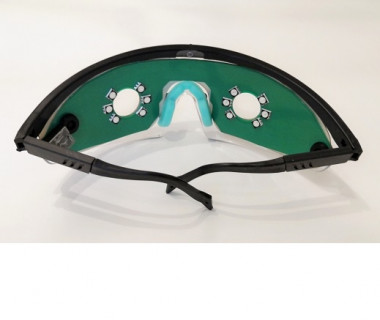Mon—Fri 11:00—17:00 Sat. 12:00—16:00

Description
After payment, a download link will be sent by e-mail.
Presence Meditation 8 - “Space” is the final training meditation from the Presence Meditations series.
Despite the fact that all these meditations are self-sufficient, but each meditation is associated with a particular aspect of perception, and, in the aggregate, all of them represent an integral system of self-improvement.
This system can be mastered in a little more than six months, if you deal with each meditation 21 times in succession (any number of times per day is considered at a time), with interruptions of no more than two days (better every day). What can be gained by mastering this system?
For example, in a study (using state-of-the-art technology designed to study the brain), published in 2001, in the journal Psychiatry Research, it was proved that an eight-week presence meditation program led to noticeable changes in the participants' brains. It was found that the parts of the brain responsible for emotional regulation, memory, and learning have become more developed.
In this way, presence meditation can help you deal with stress more effectively, improve memory, and learning ability.
Here is a far from complete list of scientifically documented improvements for those who practice presence meditation on a regular basis:
· Improving brain functioning;
· Improving attention;
· Increased clarity of thinking and perception;
· Improving immunity;
· Improving sex life;
· Decrease in arterial pressure;
· Decrease in heart rate;
· Decrease in level of alarm;
· Pain control;
· Internal peace.
It should be noted that in this series we moved from simple to complex, and this meditation is the most difficult and, at the same time, it is most similar to classical Buddhist meditations.
As I already mentioned, in one of the annotations, both external and internal space is an important part in the coding of information and emotions by the human brain, therefore this meditation (however, as in any given field of perception, each meditation in this series) provides effective dissolution of mental blocks and emotions that are “stuck in the body”, relieving accumulated stress and providing prevention of cardiovascular and oncological diseases.
Methodology
In this meditation, I, as in the previous ones, will ask questions: “Could you ...” The questions asked in this form help to circumvent current restrictions, making it possible for the subconscious to find the conditions under which the fulfillment of what has been said becomes possible (although not always the first time).
There will be 15 seconds between questions, and at this time it is necessary to keep soft friendly attention on the subject of the last question.
Important:
The training exercises are designed to increase the scope of attention and increase its flexibility. However, focusing on a goal that involves effort — that is, when a person struggles to do or imagine what they are asking for, will reduce the effectiveness of the practice. This practice will be most effective when you allow yourself to effortlessly respond to an answer and accept any response that you may have spontaneously. During the session, you should not take responsibility for the result of the practice.
Any effort will be counterproductive in the sense that this effort will be felt by a person more than the feeling of absence, which is characteristic of space - the sensory feeling of effort overshadows the feeling of absence.
However, all of the above does not mean at all that you can turn on this recording simply in the background, doing anything else in your head. Throughout the course of meditation, it is necessary to maintain soft friendly attention on my questions and on my state after questions, calmly accepting any thoughts and feelings.
Your task is to let your imagination do all the work very naturally, which, of course, does not require any effort. When your imagination acts completely freely, and you DO NOT force him to imagine something, but simply let it happen, then the imagination acts most creatively.
If you are having difficulty imagining an image or feeling, do not worry about it. Let your sensations evolve in a natural way, without extra effort: do not try to make sure that they correspond to the prejudices that you may have.
If nothing seems to happen to you, or your mind starts to wander, do not worry. This often happens in the early stages of learning and even in the later stages of various meditation practices.
In the event that you notice that your attention wanders and focuses on some thoughts, images or other feelings, you should neither resist nor strengthen this process. Just let your focus of attention expand to include the awareness and sensations arising from the current question, in addition to the direction your mind is now headed.
As in the case of other techniques that create favorable conditions for self-integration (healing - achieving integrity), practitioners of any presence meditation often notice the so-called “release phenomenon” (“autogenous discharges”) - unusual, or, perhaps, in someone’s opinion inappropriate sensations in the body.
If you feel something unusual, then just include these feelings in the circle of your soft friendly attention.
In any case, between sessions and during subsequent sessions, integration will occur spontaneously. The less you resist sensations, the more you can expand your attention to include this sensation, space and other sensations - and the more pleasant, quick and complete the integration process will be.
Presence meditations can be done with both eyes closed and open. At the initial stage, closed eyes can help focus on the sensations, but as you gain meditative experience, it is recommended to engage with open eyes in order to transfer the experience of meditation into everyday life.
The second meditation is just a shorter option (for those who want to save time), where all the auxiliary instructions that you can learn by practicing the long version several times are removed.
This meditation is self-sufficient, but each subsequent meditation in the Presence Meditation series is a little more complicated than the previous ones. Therefore, it will still be better if you first complete the full course (21 days) of basic meditation. Someone might find it useful to systematically complete the full course of all presence meditations, since each meditation in the Presence Meditations series engages and transforms some unique aspects of your perception. So consecutive classes by everyone (preferably in the order in which they appeared on the site) give a systemic synergistic effect.
Once again, I would especially like to emphasize that meditation is not hard work, but a game. During meditation, keep your inner smile, breathe deeply (effortlessly) and evenly and play with your ideas, as if half asleep, or in dreams.
In order to transfer the effects of presence meditation in everyday situations, during meditation, it is recommended to sit with your back straight or to stand. A lying or reclining position, after a certain period of practice, will be ineffective, since it resembles the position in which you are sleeping. You can even perform simple, familiar physical work - cooking, washing dishes, cleaning an apartment, etc.
It is optimal to do it twice a day, (with a break between sets of at least three hours). It should be noted that “twice a day” is a recommendation, not a dogma. In meditation, regularity is very important (especially for beginners), not the amount of time spent.
Water plays an important role in conducting nerve impulses. With general dehydration, which is very common among urban residents, a headache may occur after listening. Therefore, I recommend that before meditation and immediately after drink a glass (well, at least half) of plain clean water.
After reading and remembering, you can do this meditation yourself (from memory - without sound), during the day - in public transport, in queues, at work breaks.
It is strictly forbidden to engage in meditation while driving, or when controlling any potentially dangerous mechanisms.
The first positive changes will be noticeable after three weeks of regular classes. The consolidation of positive changes will occur in three months.
Meditation Duration: MP8_Space - 36 minutes, MP8_Space_short - 32 minutes.
Using headphones is optional.
Be Healthy and Happy!
Andrey Patrushev and Vladimir Nikonov








